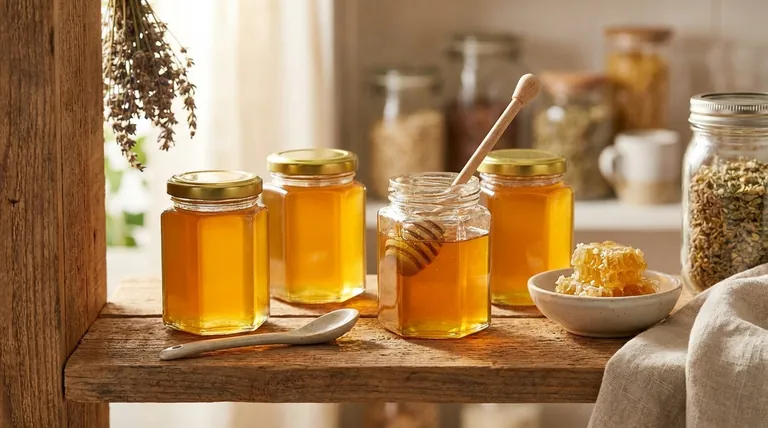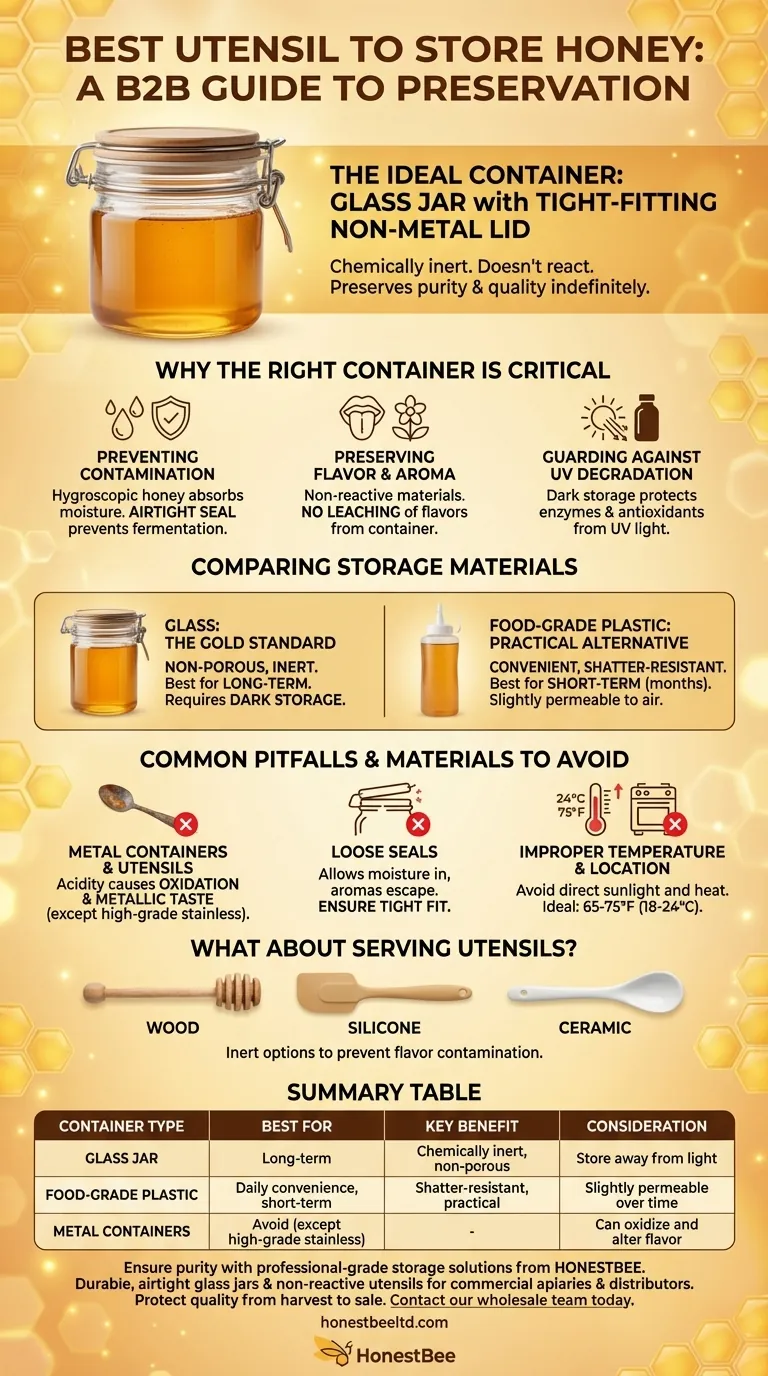For storing honey, the best container is a glass jar with a tight-fitting, non-metal lid. This combination is chemically inert, meaning it won't react with the honey or alter its flavor, even over very long periods. Food-grade plastic containers are also acceptable, but glass remains the superior choice for preserving honey's purity and quality.
The goal of honey storage is to protect it from its three main adversaries: air, light, and reactive materials. The ideal container creates a stable, inert barrier that preserves the honey's natural character indefinitely.

Why the Right Container Is Critical
Honey is a remarkably stable food, but its quality can be degraded by improper storage. The right container is not just a vessel but a protective shield.
Preventing Contamination
Honey is hygroscopic, which means it readily absorbs moisture from the air. An airtight seal is non-negotiable to prevent this, as excess moisture can lead to fermentation.
Preserving Flavor and Aroma
The container material itself can impact taste. Honey's natural acidity can react with certain materials, leaching flavors or compounds into the product over time.
Guarding Against UV Degradation
Direct sunlight and UV exposure can darken honey and degrade its beneficial enzymes and antioxidants. Storing it in a dark place or an opaque container is essential.
Comparing Storage Materials
The two most common and acceptable materials for honey storage are glass and food-grade plastic. Each has distinct advantages.
Glass: The Gold Standard
Glass is the preferred material for long-term storage. It is non-porous and completely inert, ensuring that nothing leaches into the honey.
Its transparency also allows you to appreciate the honey's natural color, though this means you must be diligent about storing it away from light.
Food-Grade Plastic: The Practical Alternative
Food-grade plastic containers, like squeeze bottles, offer convenience and are less prone to breaking. They are perfectly suitable for honey you plan to use within several months.
However, for archival storage, plastic is less ideal as it can be slightly permeable to air and may impart flavors over many years.
Common Pitfalls and Materials to Avoid
Choosing the wrong container or utensil can quickly compromise your honey. Understanding what to avoid is as important as knowing what to use.
The Problem with Metal
You should never store honey in metal containers (unless they are made of high-grade stainless steel specifically for food). The honey's acidity can cause the metal to oxidize, imparting a metallic taste and potentially introducing unwanted compounds.
This same principle applies to serving utensils; avoid leaving a metal spoon inside your honey jar.
The Importance of a Tight Seal
A loose-fitting lid is one of the most common storage mistakes. It allows moisture in and can let the honey's delicate aromas escape. Always ensure your container lid is screwed on tightly.
Temperature and Location
The ideal storage temperature for honey is between 65°F and 75°F (18°C to 24°C). Store it in a dark cabinet or pantry, away from the stove or direct sunlight.
What About Serving Utensils?
While the storage vessel is most important, the utensil you use to serve the honey also matters.
Wood, Silicone, or Ceramic
To avoid the reactivity of metal, classic wooden honey dippers are an excellent choice. Silicone spatulas or ceramic spoons are also completely inert and will not affect the honey's taste.
Choosing the Right Storage for Your Needs
Your ideal storage method depends on how you plan to use the honey.
- If your primary focus is long-term preservation: Use an airtight, dark-colored or opaque glass jar and store it in a cool, dark pantry.
- If your primary focus is daily convenience: A clear glass jar or a food-grade plastic squeeze bottle is perfectly acceptable for honey you'll use within a few months.
- If you are choosing a serving tool: Opt for a wooden dipper, silicone spatula, or ceramic spoon to prevent any risk of flavor contamination from metal.
By protecting it from the elements, you ensure your honey remains as pure and delicious as the day it was harvested.
Summary Table:
| Container Type | Best For | Key Benefit | Consideration |
|---|---|---|---|
| Glass Jar | Long-term preservation | Chemically inert, non-porous | Store away from light |
| Food-Grade Plastic | Daily convenience, short-term use | Shatter-resistant, practical | Slightly permeable over time |
| Metal Containers | Avoid (except high-grade stainless steel) | - | Can oxidize and alter flavor |
Ensure your honey's purity with professional-grade storage solutions from HONESTBEE. We supply durable, airtight glass jars and non-reactive utensils designed specifically for commercial apiaries and distributors. Protect your product's quality from harvest to sale. Contact our wholesale team today to discuss your beekeeping supply needs.
Visual Guide

Related Products
- Hexagonal Glass Honey Jars with Metal Lug Caps Elegant Versatile Packaging
- Classic Drum Shaped Glass Honey Jar with Airtight Lid
- Inverted Squeezable Honey Jar with No Drip Flip Top Cap for Easy Pouring
- Squeezable No-Drip Beehive-Shaped Honey Jars with Flip-Top Cap
- Classic Honey Bear Jars with Flip Top Dispensing Cap for Liquid Sweeteners
People Also Ask
- How should honey be stored and packaged? Preserve Flavor & Quality with Proper Containers
- What is the term for honey can absorb moisture from the air? Understanding Hygroscopy
- Why is a glass jar preferred for packaging honey? Ultimate Protection for Purity & Flavor
- What makes raw honey more aesthetically appealing than processed honey? Discover the Beauty of Authenticity
- What are the advantages of using glass jars for honey packaging? Preserve Purity & Elevate Your Brand



















